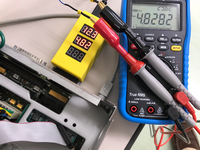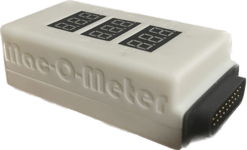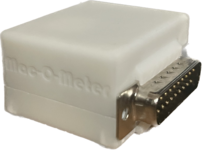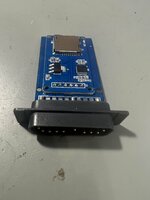Aaaaand they're gone! Thanks to everyone who ordered/expressed interest. I'm not sure that I personally will be doing this arrangement again, assembling and testing these things was a lot of work (and I already have a day job, plus holidays...) but I may be teaming up with someone to manufacture and sell TashTwenty boards if it's demonstrably a good value proposition - so please continue registering your interest if you'd like to buy!
TashTwenty - Single-Chip DCD (Hard Disk 20) Interface for Macintosh
- Thread starter Tashtari
- Start date
You are using an out of date browser. It may not display this or other websites correctly.
You should upgrade or use an alternative browser.
You should upgrade or use an alternative browser.
I only discovered the Tash20 about a week ago. Quite embarrassing that I missed this thread for so long. There's also a 68kMLA thread that's been following the project since its inception. Sorry to be so late to the game.
As an owner of multiple FloppyEMUs, I think it is useful to make a simplistic comparison and point out 3 merits of the Tash20 that I recently learned:
And for people who own a real HD20 like I do, the "Mega" (by @warmech ) sounds very interesting, as you would be putting your Tash20 Mega PCB inside the HD20 case. My Rodime is still alive and working; but from what I have read, the Mega will operate dead Rodime drives in such a way they make sounds like a working drive, all while the access is being done from the Tash20's SD card. Quite amazing, really. It's not clear to me if the Tash20 Mega's controller shaped PCB is made ONLY for HD20s that have dead Rodime drives, or if it will daisy chain SD card Tash20's alongside the working Rodime. I see the last post in this thread by @warmech was made in December 2022 when he anticipated more info soon, so it would be wonderful to hear an update from him about the project.
I've also been speaking with Will of CayMac Vintage over the last few days regarding Tash20 edition his Ko-Fi store has sold (based on the open source designs). That Tash20 is the PIC16F1825 version. It's currently Sold Out, but they are brewing up something for another release.
One post in that 68kMLA thread mentioned that the 1825 firmware reported 1 less sector of capacity than actual on the card. Not sure if that was later resolved, or even if it is a big deal, but I did notice that and wanted to mention it.
As an owner of multiple FloppyEMUs, I think it is useful to make a simplistic comparison and point out 3 merits of the Tash20 that I recently learned:
- Compact size (in large part due to the lack of LCD and buttons)
- Daisy chain support via SD card partitions — support for up to 2, except on the 512Ke & Plus which support 4 (varies by Mac's ROM), but the forthcoming Tash20 Mega might exceed these limits
- Custom icons (on the PIC16F1704 version mentioned in this thread, not the earlier PIC16F1825 edition)
And for people who own a real HD20 like I do, the "Mega" (by @warmech ) sounds very interesting, as you would be putting your Tash20 Mega PCB inside the HD20 case. My Rodime is still alive and working; but from what I have read, the Mega will operate dead Rodime drives in such a way they make sounds like a working drive, all while the access is being done from the Tash20's SD card. Quite amazing, really. It's not clear to me if the Tash20 Mega's controller shaped PCB is made ONLY for HD20s that have dead Rodime drives, or if it will daisy chain SD card Tash20's alongside the working Rodime. I see the last post in this thread by @warmech was made in December 2022 when he anticipated more info soon, so it would be wonderful to hear an update from him about the project.
I've also been speaking with Will of CayMac Vintage over the last few days regarding Tash20 edition his Ko-Fi store has sold (based on the open source designs). That Tash20 is the PIC16F1825 version. It's currently Sold Out, but they are brewing up something for another release.
One post in that 68kMLA thread mentioned that the 1825 firmware reported 1 less sector of capacity than actual on the card. Not sure if that was later resolved, or even if it is a big deal, but I did notice that and wanted to mention it.
Moof disk file support continues to be a FloppyEMU exclusive in the hardware world. I consider those to be historically important as well as technically very useful, as they allow you to run copy protected disks without having to either learn extremely specialized hacker skills or pester the dwindling ever shrinking small pool of people who do.
On the emulation side, only the average MAME emulator supports it.
On the emulation side, only the average MAME emulator supports it.
Indeed, and my previous post does not seek to, in any way, diminish the importance of the FloppyEMU. Everyone should own at least one. I personally own two (Revs B & C).Moof disk file support continues to be a FloppyEMU exclusive
But the Tash20 doesn't support floppy drive images (to my knowledge), which means the lack of moof support own the Tash20 is moot. Tash20 appears to be a one trick pony in that it emulates only a Hard Disk 20. Because of that, it doesn't need buttons or the LCD, and can therefore be made physically smaller. Being smaller than a FloppyEMU is nice if you want a tiny little device hanging off the back of your compact Mac's external floppy drive connector (where the Apple HD20 would normally attach).
The good news is that Will (Caymac Vintage) will have them on his Ko-Fi store again soon. I actually received an email from him only moments ago, and it seems he may also offer some Tash20 units with the PIC16F1704 chips,I wanted one but missed out too.
By the way, I also have one of his Vintage Mac Voltmeters, which conveniently measures 3 voltages at the same time from the external floppy disk connector. (On the SE/30, no negative voltage is available.) I am prepping to do a video about that soon. That nifty device is a creation of Will, along with Joakim Larsson (based in Sweden) and 68kMLA member Jake / Jajan547 (based in the USA). I must say it is quite accurate. It was spot on with my EEVBlog 121GW meter. It has a Mini DIN connector that allows a cable to be attached, and it was to that I connected by 121GW in the photo below. Pretty neat little device.

I should make the point clear that the PIC16F1825 firmware is deprecated at this point and anyone building a device should be using the PIC16F1704 and its associated firmware. I would have pointed this out to CayMac Vintage, except I didn't know they were selling TashTwenty devices until someone else mentioned it to me (they're welcome to do so, of course, as is anybody else, the firmware and PCB designs are open source for that reason).
The 1825 firmware still works and both devices are pin-compatible, but in addition to the support for custom icons, the 1704 firmware uses the memory card adapter's activity light to blink out a trouble code whenever there's an issue with the card that keeps it from functioning - it's nice when troubleshooting issues not to have to lead with "do you own an oscilloscope". =) Also, it should be slightly faster - the 1825 firmware loads a sector into memory before transmitting or storing it, while the 1704 copies data directly in both directions (though the biggest limiting factor is the speed of the DCD interface to the Mac).
While I'm looking forward to the Mega board as much as anyone else, it won't allow for any more DCD devices than are currently supported by any other TashTwenty board - the limitation of 2 or 4 DCD devices in a daisy chain is purely in the ROM. DCD itself, in fact, places no limit on the number of DCD devices that can be daisy chained - it only knows "select first device" and "select next device" - a single daisy chain could support an infinite number of DCD devices if not for limits imposed by the ROM (and by cabling, of course).
As @JDW pointed out, TashTwenty has no way to support MOOF images as it only emulates DCD devices (i.e. HD20-like devices). DCD is a high-level protocol that effectively repurposes the IWM-based floppy interface to act as a high-speed serial interface and it deals directly in digital data in much the same way SCSI does - the Mac only knows it's dealing with a storage device, it doesn't know or care what the underlying media is.
I would like to produce my own full-fledged floppy drive emulator at some point, but it's a difficult task to begin with and some restrictions I've placed on myself make it more so - I could probably have completed it by now if I was using a more advanced embedded system, but I like working with 8-bit PICs and SPLDs because I am silly, and I write firmware for fun, not profit. =) Maybe someday. TashTwenty pleases me as a project because its logic is entirely contained within a single 8-bit PIC, no FPGA or CPLD or SPLD needed... I'd tried to develop a floppy emulator that was entirely self-contained as well, but the necessary tradeoffs would have made it a less functional device than I want to deliver.
Anyway, I'm glad others are producing devices and making them available for sale and I hope that everyone who wants one is able to get one - operating a store is not where my interest lies. It makes me happy that people are discovering TashTwenty and finding it useful. That's all I hope for with all my projects (like TashTalk, TashThird, and TashIO... check 'em out if you haven't already!) =)
The 1825 firmware still works and both devices are pin-compatible, but in addition to the support for custom icons, the 1704 firmware uses the memory card adapter's activity light to blink out a trouble code whenever there's an issue with the card that keeps it from functioning - it's nice when troubleshooting issues not to have to lead with "do you own an oscilloscope". =) Also, it should be slightly faster - the 1825 firmware loads a sector into memory before transmitting or storing it, while the 1704 copies data directly in both directions (though the biggest limiting factor is the speed of the DCD interface to the Mac).
While I'm looking forward to the Mega board as much as anyone else, it won't allow for any more DCD devices than are currently supported by any other TashTwenty board - the limitation of 2 or 4 DCD devices in a daisy chain is purely in the ROM. DCD itself, in fact, places no limit on the number of DCD devices that can be daisy chained - it only knows "select first device" and "select next device" - a single daisy chain could support an infinite number of DCD devices if not for limits imposed by the ROM (and by cabling, of course).
As @JDW pointed out, TashTwenty has no way to support MOOF images as it only emulates DCD devices (i.e. HD20-like devices). DCD is a high-level protocol that effectively repurposes the IWM-based floppy interface to act as a high-speed serial interface and it deals directly in digital data in much the same way SCSI does - the Mac only knows it's dealing with a storage device, it doesn't know or care what the underlying media is.
I would like to produce my own full-fledged floppy drive emulator at some point, but it's a difficult task to begin with and some restrictions I've placed on myself make it more so - I could probably have completed it by now if I was using a more advanced embedded system, but I like working with 8-bit PICs and SPLDs because I am silly, and I write firmware for fun, not profit. =) Maybe someday. TashTwenty pleases me as a project because its logic is entirely contained within a single 8-bit PIC, no FPGA or CPLD or SPLD needed... I'd tried to develop a floppy emulator that was entirely self-contained as well, but the necessary tradeoffs would have made it a less functional device than I want to deliver.
Anyway, I'm glad others are producing devices and making them available for sale and I hope that everyone who wants one is able to get one - operating a store is not where my interest lies. It makes me happy that people are discovering TashTwenty and finding it useful. That's all I hope for with all my projects (like TashTalk, TashThird, and TashIO... check 'em out if you haven't already!) =)
@JDW thank you so much for the positive posts. Yes, the CayMac team is very proud of the meter and see it as a great tool to help. I found it very hard to measure voltages from the floppy port and having to do other work. We have updated the case and the extension adapter to have a better case. The new version will not come with a cable as you can use your own ADB keyboard cable as the adapter has a miniDIN plug on it. I am sure many of us using the meter have a few of these around the place. Lol.The good news is that Will (Caymac Vintage) will have them on his Ko-Fi store again soon. I actually received an email from him only moments ago, and it seems he may also offer some Tash20 units with the PIC16F1704 chips,
By the way, I also have one of his Vintage Mac Voltmeters, which conveniently measures 3 voltages at the same time from the external floppy disk connector. (On the SE/30, no negative voltage is available.) I am prepping to do a video about that soon. That nifty device is a creation of Will, along with Joakim Larsson (based in Sweden) and 68kMLA member Jake / Jajan547 (based in the USA). I must say it is quite accurate. It was spot on with my EEVBlog 121GW meter. It has a Mini DIN connector that allows a cable to be attached, and it was to that I connected by 121GW in the photo below. Pretty neat little device.
View attachment 12546
The tash20, I was using the 1825 chip as I could not get the 1704 at that time. I have ordered in total 50 of the 1704 and will start using them instead of the 1825. Note that Joakim had developed his own board based on the fabulous TashTari board to use a different sd card reader and smd items to lower the cost. Our intension is to provide these for others at the lowest price we can while still having quality. We use our own 3d resign printed db19 connector. I will have these back on the site in a week or 2. We will not include a case but you can get the stl and print your own. This again, is to lower the price.
attached are pics of the new meter case and adapter and the tash20 that we call Tash20 Budget.
I again like to thank @JDW and @Tashtari i looking forward to working with you both on any creative tasks ahead.
Attachments
Last edited:



